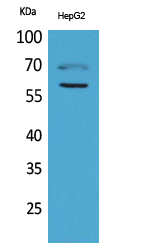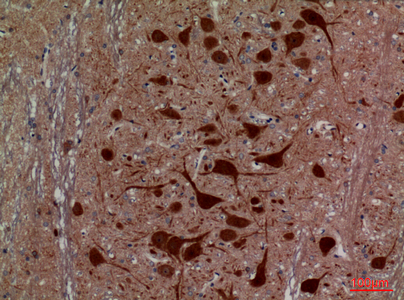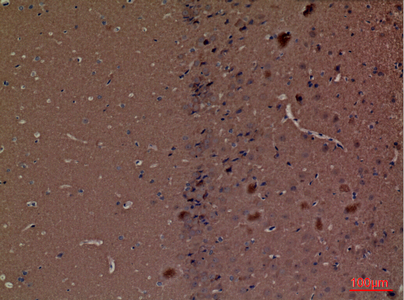产品名称
HEXA Rabbit Polyclonal Antibody
别名
HEXA; Beta-hexosaminidase subunit alpha; Beta-N-acetylhexosaminidase subunit alpha; Hexosaminidase subunit A; N-acetyl-beta-glucosaminidase subunit alpha
蛋白名称
Beta-hexosaminidase subunit alpha
存储缓冲液
Liquid in PBS containing 50% glycerol, 0.5% BSA and 0.02% New type preservative N.
Human Gene Link
http://www.ncbi.nlm.nih.gov/sites/entrez?db=gene&term=3073
Human Swissprot No.
P06865
Human Swissprot Link
http://www.uniprot.org/uniprotkb/P06865/entry
Mouse Gene Link
http://www.ncbi.nlm.nih.gov/sites/entrez?db=gene&term=15211
Mouse Swissprot No.
P29416
Mouse Swissprot Link
http://www.uniprot.org/uniprot/P29416
Rat Gene Link
http://www.ncbi.nlm.nih.gov/sites/entrez?db=gene&term=300757
Rat Swissprot Link
http://www.uniprot.org/uniprot/Q641X3
免疫原
Synthesized peptide derived from HEXA . at AA range: 121-170
特异性
HEXA Polyclonal Antibody detects endogenous levels of HEXA protein.
稀释度
WB 1:500 - 1:2000. IHC-p: 1:100-300 ELISA: 1:20000.. IF 1:50-200
宿主
Polyclonal, Rabbit,IgG
背景介绍
This gene encodes a member of the glycosyl hydrolase 20 family of proteins. The encoded preproprotein is proteolytically processed to generate the alpha subunit of the lysosomal enzyme beta-hexosaminidase. This enzyme, together with the cofactor GM2 activator protein, catalyzes the degradation of the ganglioside GM2, and other molecules containing terminal N-acetyl hexosamines. Mutations in this gene lead to an accumulation of GM2 ganglioside in neurons, the underlying cause of neurodegenerative disorders termed the GM2 gangliosidoses, including Tay-Sachs disease (GM2-gangliosidosis type I). Alternative splicing results in multiple transcript variants, at least one of which encodes a preproprotein that is proteolytically processed. [provided by RefSeq, Jan 2016],
组织表达
Brain,Eye,Liver,Ovary,Uterus,
信号通路
Other glycan degradation;Amino sugar and nucleotide sugar metabolism;Glycosaminoglycan degradation;Glycosphingolipid biosynthesis;Glycosphingolipid biosynthesis;Lysosome;
功能
catalytic activity:Hydrolysis of terminal non-reducing N-acetyl-D-hexosamine residues in N-acetyl-beta-D-hexosaminides.,disease:Defects in HEXA are the cause of GM2-gangliosidosis type 1 (GM2G1) [MIM:272800]; also known as Tay-Sachs disease. GM2-gangliosidosis is an autosomal recessive lysosomal storage disease marked by the accumulation of GM2 gangliosides in the neuronal cells. GM2G1 is characterized by GM2 gangliosides accumulation in the absence of HEXA activity, leading to neurodegeneration and, in the infantile form, death in early childhood. GM2G1 has an increased incidence among Ashkenazi Jews and French Canadians in eastern Quebec. It exists in several forms: infantile (most common and most severe), juvenile and adult (late onset).,function:Responsible for the degradation of GM2 gangliosides, and a variety of other molecules containing terminal N-acetyl hexosamines, in the brain and other tissues. The form B is active against certain oligosaccharides. The form S has no measurable activity.,online information:HEXA mutation database,online information:Tay Sachs disease website,PTM:N-linked glycan at Asn-115 consists of Man(3)-GlcNAc(2).,similarity:Belongs to the glycosyl hydrolase 20 family.,subunit:There are 3 forms of beta-hexosaminidase: hexosaminidase A is a trimer composed of one subunit alpha, one subunit beta chain A and one subunit beta chain B; hexosaminidase B is a tetramer of two subunit beta chains A and two subunit beta chains B; hexosaminidase S is an homodimer of two alpha subunits. The two beta chains are derived from the cleavage of the beta subunit.,
纯化
The antibody was affinity-purified from rabbit antiserum by affinity-chromatography using epitope-specific immunogen.

.jpg)
.jpg)


